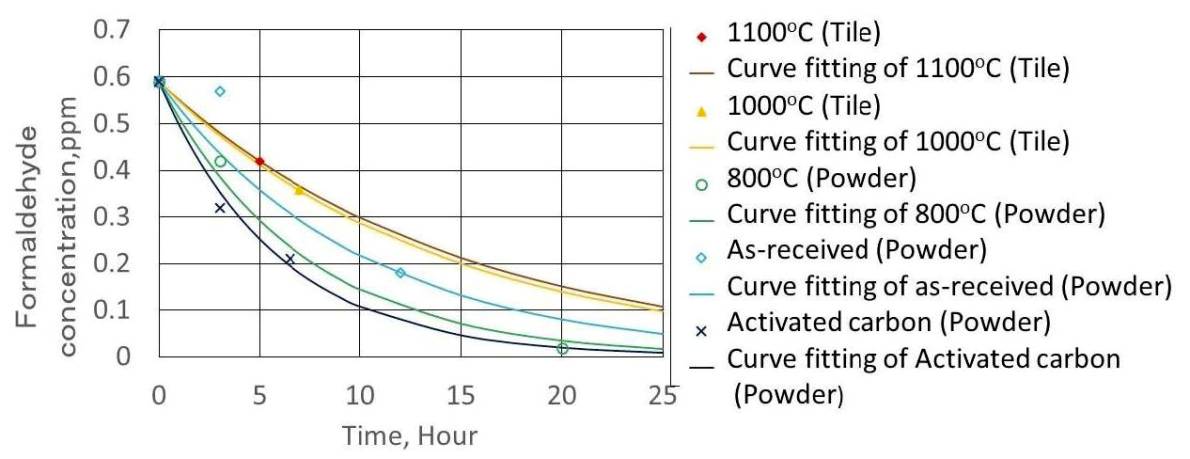You are currently viewing a beta version of our website. If you spot anything unusual, kindly let us know.
Preprint
Article
Production of Hydroxyl Radical and Removal of Formaldehyde by Calcined Green Tuff Powder and Tile
Altmetrics
Downloads
281
Views
273
Comments
0
A peer-reviewed article of this preprint also exists.
This version is not peer-reviewed
Abstract
Wasted Green tuff powder produced by cutting Towada stone is recycled as environmental cleaning material. The optimum temperature for green tuff powder calcination to reduce the hydroxyl radical produced in hydrogen peroxide decomposition with ultraviolet light (UV) and no light. The green tuff calcined at 800 °C shows the large decomposition rate of hydrogen peroxide with no UV light when measured by using ESR. With UV light, the optimum temperature for calcinating the green tuff powder in order to reduce hydroxyl radical is also 800 °C. Next, the powder calcined at 800 °C is used to produce the tile by compression and heating, and then the formaldehyde adsorption rate was measured. The green tuff powder calcined at 800 °C showed a high adsorption rate, similar to that of the activated carbon. The tiles formed at 40 MPa and heated st 1100 °C were the strongest and also adsorbed formaldehyde. The adsorbed formaldehyde on the green tuff tile and powder might have a possibility to decompose by photocatalytic.

Keywords:
Subject: Engineering - Chemical Engineering
Copyright: This open access article is published under a Creative Commons CC BY 4.0 license, which permit the free download, distribution, and reuse, provided that the author and preprint are cited in any reuse.
Submitted:
10 May 2019
Posted:
13 May 2019
You are already at the latest version
Alerts
A peer-reviewed article of this preprint also exists.
This version is not peer-reviewed
Submitted:
10 May 2019
Posted:
13 May 2019
You are already at the latest version
Alerts
Abstract
Wasted Green tuff powder produced by cutting Towada stone is recycled as environmental cleaning material. The optimum temperature for green tuff powder calcination to reduce the hydroxyl radical produced in hydrogen peroxide decomposition with ultraviolet light (UV) and no light. The green tuff calcined at 800 °C shows the large decomposition rate of hydrogen peroxide with no UV light when measured by using ESR. With UV light, the optimum temperature for calcinating the green tuff powder in order to reduce hydroxyl radical is also 800 °C. Next, the powder calcined at 800 °C is used to produce the tile by compression and heating, and then the formaldehyde adsorption rate was measured. The green tuff powder calcined at 800 °C showed a high adsorption rate, similar to that of the activated carbon. The tiles formed at 40 MPa and heated st 1100 °C were the strongest and also adsorbed formaldehyde. The adsorbed formaldehyde on the green tuff tile and powder might have a possibility to decompose by photocatalytic.

Keywords:
Subject: Engineering - Chemical Engineering
Copyright: This open access article is published under a Creative Commons CC BY 4.0 license, which permit the free download, distribution, and reuse, provided that the author and preprint are cited in any reuse.
Solubility and Activation of Hydrogen in the Non-Catalytic Upgrading of Venezuela Orinoco, China Liaohe, and China Fengcheng Atmospheric Residues
Shunfeng Ji
et al.
Processes,
2021
Effect of Absorption Time for the Preparation of Activated Carbon from Wasted Tree Leaves of Quercus alba and Investigating Life Cycle Assessment
Muhammad Amin
et al.
C,
2022
Study on Reduction of Partially Oxidized Cauliflower-like Copper Powder by Hydrogen
Juan An
et al.
Metals,
2022
MDPI Initiatives
Important Links
© 2024 MDPI (Basel, Switzerland) unless otherwise stated






